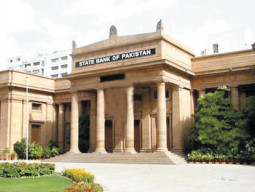
There has been a perceptible improvement in the country’s macroeconomic indicators with decreasing inflationary pressure, improving foreign exchange reserves position and a growing large-scale manufacturing (LSM) sector, according to the second quarterly report for 2013-14 released by the State Bank of Pakistan (SBP) on Friday.
However, the SBP says the improvement in the fiscal and external accounts in the second half of 2013-14 depends on the expected proceeds from the auction of 3G licences and Coalition Support Fund (CSF) inflows. “If expected official external inflows are realised in the second half of 2013-14, SBP’s foreign exchange reserves are likely to exceed our initial projection for the full year,” it said.

The report traced the recent comfort on the external side to an unanticipated $1.5 billion inflow into the SBP’s reserves, which could have triggered market expectations that Pakistan may receive a facility to defer oil payments in the last quarter of 2013-14. “Along with dampening inflationary expectations for the remaining part of 2013-14, this has changed the market’s interest rate outlook. The SBP projects average inflation in 2013-14 to be in the range of 8.5-9.5%,” it said.
The report says that due to a decline in cotton production, the prospects of achieving the gross domestic product (GDP) growth target in 2013-14 could be undermined. However, LSM continues to post strong growth, which bodes well for the country’s overall economic growth, it said. The rebound in LSM is supported by investments in alternate energy sources, improved power supply after the resolution of the circular debt, capacity enhancement in steel, paper, fertiliser, beverages, and rubber in the last few years, and increased lending to private-sector businesses, especially in fixed investment loans.
According to the report, the government mobilised Rs188.1 billion from commercial banks during the second quarter of 2013-14 against a net retirement of Rs179.1 billion in the first quarter of the year. The government was not able to contain its borrowing from the SBP within the limit agreed with the International Monetary Fund (IMF). “However, with the bilateral inflows in February and March, and other external inflows expected in the second half of 2013-14, these targets should be easier going forward,” it said.
The report says the fiscal deficit during the first half of 2013-14 narrowed to 2.1% of GDP because of a slowdown in spending and an increase in revenues as opposed to 2.7% in the same period of the last fiscal year.
The report also pointed out that fiscal austerity was hurting development spending both at federal and the provincial levels, which may be attributed to a lack of external funding. “In our view, there is a need to rethink this avenue of fiscal consolidation within the context of long-term growth prospects of the economy,” it said.
Referring to the headline inflation that fell to 9.2% in December after entering double digits in November, the SBP said the downward trend is likely to persist in the future.
Foreign exchange reserves remained under pressure until the end of November due to the absence of financial inflows and large repayments to the IMF. However, the situation improved in December after the receipt of the second installment of $554 million Extended Fund Facility (EFF) from the IMF and a current account surplus in the same month.
Published in The Express Tribune, March 29th, 2014.
Like Business on Facebook, follow @TribuneBiz on Twitter to stay informed and join in the conversation.
COMMENTS (3)
Comments are moderated and generally will be posted if they are on-topic and not abusive.
For more information, please see our Comments FAQ


































































Thanks for all your information Kind regards Akhtar
Seems like a light at the end of tunnel, but government needs to translate all this macroeconomic improvement into ordinary personal improvement soon.